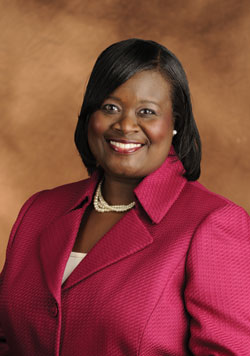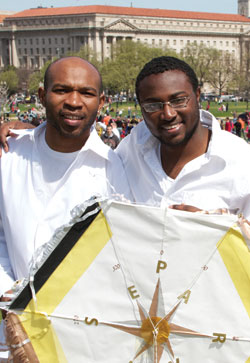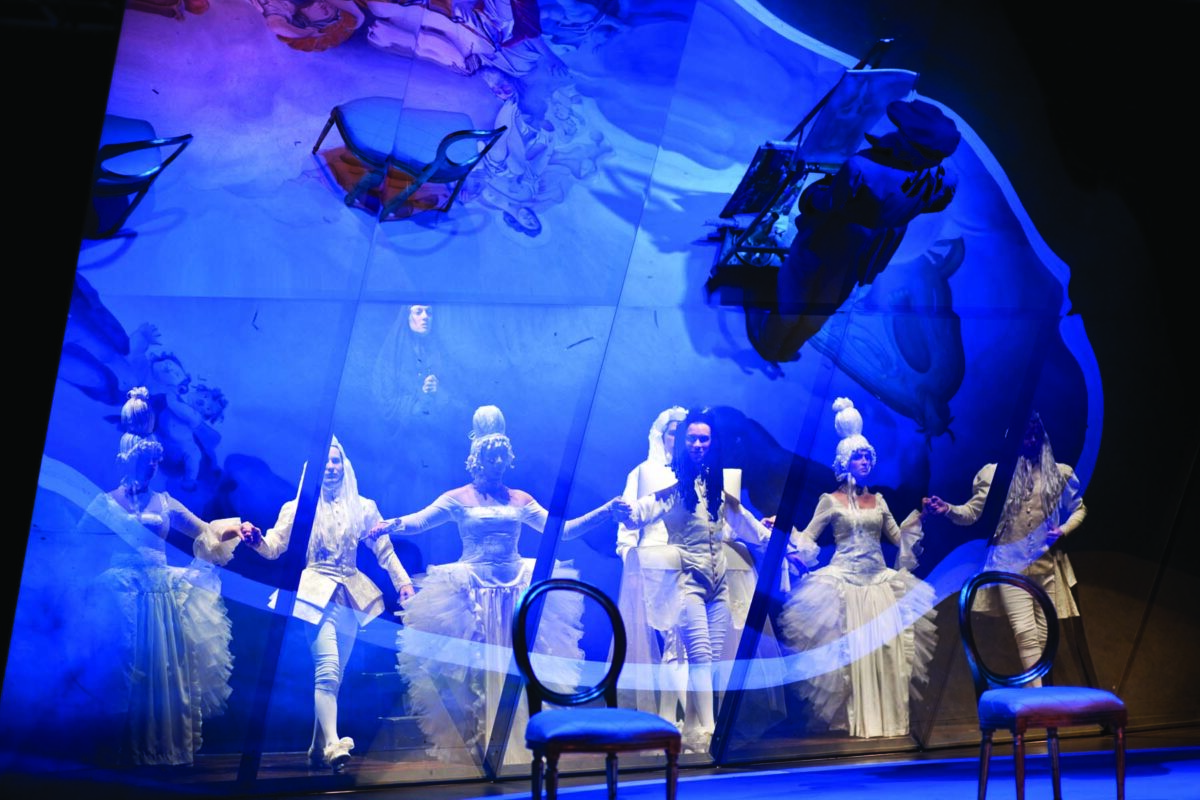MERGERS AND MAJORS
When it comes to shifting tides in disciplines from the social sciences to the humanities to engineering, UMBC’s academic leadership and its scholars aren’t standing still. They’re exploring new vistas that respond to the challenges of our moment.
The growing importance of Asia in world affairs, for instance, has led the university to create a new interdisciplinary Asian Studies major, minor and certificate program. The effort was spearheaded by professor of Japanese and East Asian history Constantine Vaporis, who has pursued the new program since 1993 and finally achieved his goal.
“What seemed like a prohibitively expensive program to create in 1993 has become far more affordable today, due to things like the strategic hiring of professors with expertise in Asian affairs over the past few years,” says Vaporis.
Melding disciplines into a coherent course of study in Asian affairs was key. “We wanted the major to be broad-based and interdisciplinary in nature, and to strike a balance between language and area study,” observes Vaporis. “This entails a bit of a balancing act, which is why the major is structured the way it is, with five electives in at least three different disciplines (in addition to the two required courses and minimum two years language study). We felt that this broad-based curriculum would prepare students best for the various professional paths related to Asia, such as advanced academic research, international relations, international business and trade, government service and international law.”
And as America’s citizens, its government and its industry become increasingly concerned with climate change and its effects, turning the good intentions of sustainability into concrete achievements requires a new generation of engineers to assess environmental challenges and solve them.
To help train that generation, and to help them get started sooner in their academic careers, the College of Engineering and Information Technology has merged its chemical and biochemical engineering department and its civil and environmental engineering departments into a new chemical, biochemical, and environmental engineering department.
Julia M. Ross, professor and chair of the new department, says the merger “allowed us to build on the existing research synergy and develop an undergraduate track in environmental engineering and sustainability that leads to the B.S. in chemical engineering.”
Combining the departments, she adds, also “provided an opportunity for growth and increased stability.”
That research collaboration is key, continues Ross. “In the former civil and environmental engineering department,” she says, “much of the environmental research being done overlapped core areas in chemical engineering such as fluid mechanics, mass transfer, reaction kinetics and separation processes. Similarly, the research in chemical and biochemical engineering focused on bio-related areas, often on problems related to these same core areas in chemical engineering.”
Ross says that the new department will “target research areas at the interface between environmental engineering and biochemical/biomedical engineering – environmental microbiology, environmental chemistry, environmentally sustainable energy processes, biofuels and multi-scale modeling.”
CAN YOU HEAR ME NOW?
Commercials will tell you to blame your cell phone carrier for problems with reception. They’re partly right, though location also plays a role — a Metro train might not be the best place for a heart-to-heart with a loved one.
But a seldom acknowledged source of bad reception comes from a basic challenge of signal processing. Cell phones convert data from two distinct channels of radio waves into information that can be used and understood. The same signal processing challenge applies for a wide range of devices used in communications, medicine and other fields.
For decades, engineers made various assumptions to simplify the data so they could design devices efficiently. They traded clarity for speed, reducing costs but also leaving us with garbled phone calls and reduced precision for some medical tests.
Now researchers at UMBC are receiving wide recognition for describing a mathematical technique that allows researchers to avoid this tradeoff.
“People have been making simplifying assumptions that don’t make good use of the data,” explains Tülay Adali, a professor of computer science and electrical engineering. “With the framework we developed, researchers don’t have to do that.”
The technique is not technically new. The researcher D.H. Brandwood described similar ideas in a 1983 paper. But Adali describes a “lightbulb” moment in 2006 when she was discussing that paper with Hualiang Li ’08, Ph.D., electrical eningeering, who has since become a research assistant professor at UMBC.
The two researchers realized the technique could be applied broadly to process a range of data without having to simplify those assumptions.
“People had missed that one elegant, simple point,” Adali says.
Subsequent research at UMBC linked the technique to work published in the early 20th century by the Austrian mathematician Wilhelm Wirtinger. Adali and Li, along with Mike Novey ’09, Ph.D., computer science, and French researcher Jean-Francois Cardoso, described the technique and developed a framework for applying it to a range of problems in “Complex ICA Using Nonlinear Functions,” a paper published in IEEE Transactions on Signal Processing in 2008.
The four researchers were honored in May with the 2010 IEEE Signal Processing Society Best Paper Award, presented in Prague at the 2011 International Conference on Acoustics, Speech and Signal Processing. Given annually, the award recognizes up to six recent papers with significant impact on the field.
While cell phone reception problems frustrate many consumers on a daily basis, the same challenges present themselves in satellite communications, acoustics, radar, medical imaging and other fields. Adali’s research now focuses on an analysis of medical data from functional magnetic resonance imaging (fMRI) and other sources. Researchers often use fMRI to see what is happening in subjects’ brains while they are at rest or performing tasks such as driving or solving problems.
Applying Wirtinger’s techniques to analyze fMRI data, Adali and her colleagues have shown, on average, a 20 percent improvement in sensitivity detecting brain activity. The technique also does a better job highlighting which brain regions are involved in certain tasks, providing insights that can be used to more accurately diagnose mental disorders.
It’s a discovery that translates into shorter, more accurate tests and, for the broad field of signal processing, a more effective and efficient way to use data.
BUILDING A TRADITION
The path to preserving Maryland’s traditional arts and culture sometimes begins when a jazz musician walks through an unlocked door in UMBC’s Fine Arts building.
One of Baltimore’s master jazz musicians, Lafayette Gilchrist ’92, Africana studies, was taking a summer class before his freshman year when he discovered that the building’s piano rooms were left open in the evening. One night, he finally gave in to temptation.
“The very first piano I played was this nine foot Steinway grand piano,” recalls Gilchrist, who had taken no formal lessons before coming to UMBC. “People think I’m lying when I tell them this, but the piano was in a concert hall, all the lights were off and there was a spotlight on it,” he said. “I fell in love. The music moved directly from my body to the instrument and into the air.”
Gilchrist audited composition classes during his time at UMBC and he was even hired to play at campus events. His musical passion and skill also eventually led him to Maryland Traditions – a statewide program that supports efforts to find, share, preserve and sustain traditional arts and culture.
Over the past academic year, Maryland Traditions has forged an exploratory partnership with UMBC that has not only brought Gilchrist back to campus for a March 30 event centered on introducing the program’s artists to the UMBC community, but created classes and events throughout the year.
The university installed Elaine Eff, the program’s co-director, as a folklorist-in-residence in the American studies department. In that role, Eff has connected UMBC students with internship opportunities, created a film series for campus and co-taught a humanities scholars class on Maryland’s traditions with Nicole King, an assistant professor of American studies.
“Elaine is such a force,” observes King. “She’s bringing the energy of the public programming realm here to the university.”
One of Maryland Traditions’ cornerstones is a Master-Apprentice program in which Gilchrist has been working. He first served as an apprentice to jazz saxophonist Carl Grubbs, and now Gilchrist is a mentor himself – advising pianist Ethan Simon (son of The Wire’s creator David Simon.)
Making strong connections is a key to the collaboration’s success. King says that Eff’s connections are invaluable to an American studies department, which has aspirations (especially with the recent establishment of its Orser Center for the Study of Place, Community & Culture at UMBC) to become a center for Baltimore area community studies.
“If we have these relationships with outside organizations and people,” King adds, “we don’t have to re-invent the wheel every time we go to work with the community.”
Eff says that the benefits of UMBC’s own pre-existing networks can’t be overstated. The university’s reach has allowed her to recruit interns for Maryland Traditions, inspire students to turn an analytic eye honed in campus classrooms to their own communities, and tap into the cultural knowledge of UMBC’s ethnic student organizations.
Who knows? Eff may find the next Lafayette Gilchrist practicing in the Fine Arts building after hours. “Every accomplishment we have here has tremendous value in building towards the future,” she concludes.
— Chelsea Haddaway
WE ARE THE ’80s?
Those who study 20th century America can point to many decades as culturally pivotal time spans. The boom and bust Jazz Age of the 1920s. The “Greatest Generation” and its role in World War II and the Cold War dominated the 1940s and 1950s. And the vast upheavals of the 1960s have made it perhaps the most written-about decade in all of American history.
But what about the 1980s – which began with the election of Ronald Reagan and ended with the fall of the Berlin Wall? The decade has attracted the attention of Kimberly R. Moffitt, assistant professor of American studies, and Duncan A. Campbell, lecturer in American studies, who have collaborated on an edited collection of essays: The 1980s: A Critical and Transitional Decade (Lexington Books).
Campbell points out that Reagan was the decade’s key political figure – and that with “the 30th anniversary of his inauguration and centenary of his birth, there’s been a bit of a Reaganesque revival” that is not limited to conservatives who shared the Gipper’s views.
But as a skeptic of the “great man” school of history, Campbell and his co-editor Moffitt also “seek to question just how much of what is classified as ’80s culture could be attributed to Reagan in either a positive or negative sense…. Reagan was very much a product of his time and the circumstances preceding and surrounding it.”
The essays collected by Moffitt and Campbell span the era’s politics and the culture, and the book teems with pieces that tackle the politics of AIDS and apartheid, as well as the triumphs of MTV and Bill Cosby.
Moffitt says that the significance of major black artists such as Cosby and Michael Jackson was that they “were able to broaden our understanding of this culture in ways that resembled the familiar for most Americans; hence their successful crossover appeal. This was a major shift or transition from previous decades in which we saw most black performers catering to all-black audiences or television programs and films with majority slack casts that featured the downtrodden, poverty-stricken, and racially segregated realities of a people.”
These successes, as well as the pervasive influence of hip-hop, she adds, “is paramount in that black culture received a platform, even in the midst of the conservatism of Reagan, to be seen by America (and the world) in a new perspective and embraced as instrumental to the creation of much of the pop culture of the ’80s and beyond.”
The ’80s also saw the rise of the machine that now dominates our lives, says Campbell. “Our wired world simply wouldn’t have taken the form it has without the personal computer,” he observes. “Few people used computers either at work or for play prior to 1980. By 1989 most middle-class Americans almost certainly did. We’re still in the middle of this revolution – and thus for the end results, in the words of Zhou Enlai on the French Revolution, it’s too soon to tell.”
— Richard Byrne ’86
Tags: Summer 2011



